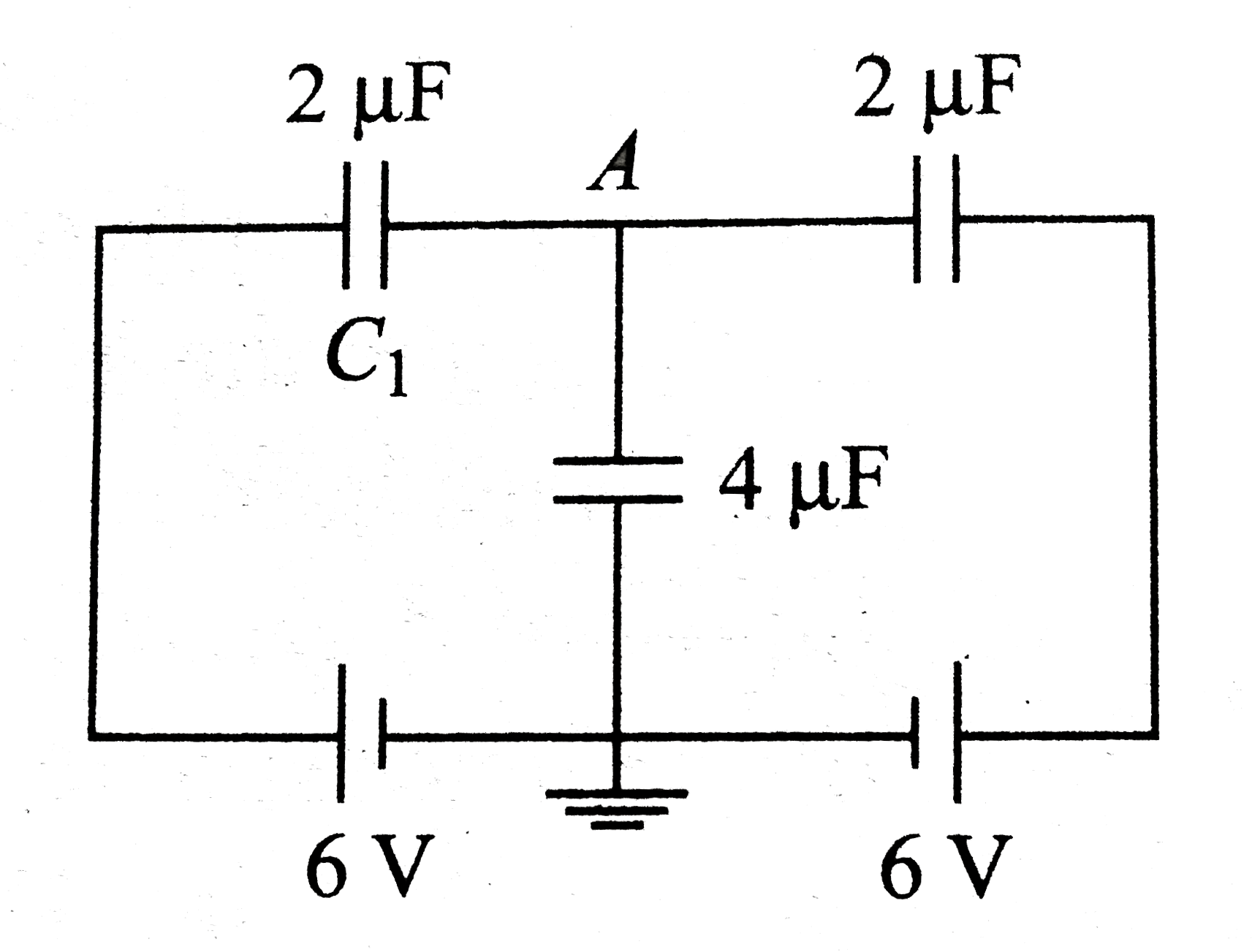Two capacitors C1 and C2 are charged 2uF AND 3uF seperately to potentials 20Vand10V, respectively. The terminals of capacitors C1andC2 are marked as (A-B) and (C-D), respectvely. A is connected with CandB is connected with D.
i. Find the final potential dsifference across each eapacitors.
ii. Find the final charge in both capacitors
iii. How much heat is produced in the circuit.
Let's solve the problem step by step.
Given Data:
- Capacitor C1=2μF charged to V1=20V
- Capacitor C2=3μF charged to V2=10V
Step 1: Calculate the initial charges on each capacitor.
The charge Q on a capacitor is given by the formula:
Q=C⋅V
- For C1:
Q1=C1⋅V1=2μF⋅20V=40μC
- For C2:
Q2=C2⋅V2=3μF⋅10V=30μC
Step 2: Determine the final potential difference across each capacitor after connection.
When the capacitors are connected, charge will redistribute until they reach the same potential. The total charge Qtotal is conserved:
Qtotal=Q1+Q2=40μC+30μC=70μC
The equivalent capacitance Ceq for capacitors in parallel is:
Ceq=C1+C2=2μF+3μF=5μF
Using the formula for voltage V=QC:
Vfinal=QtotalCeq=70μC5μF=14V
Step 3: Calculate the final charge on each capacitor.
Using the final voltage:
- For C1:
Q′1=C1⋅Vfinal=2μF⋅14V=28μC
- For C2:
Q′2=C2⋅Vfinal=3μF⋅14V=42μC
Step 4: Calculate the heat produced in the circuit.
The initial energy stored in the capacitors before connection is given by:
Uinitial=12C1V21+12C2V22
Calculating:
Uinitial=12⋅2μF⋅(20V)2+12⋅3μF⋅(10V)2
=12⋅2⋅400+12⋅3⋅100
=400μJ+150μJ=550μJ
The final energy stored after connection is:
Ufinal=12C1(Vfinal)2+12C2(Vfinal)2
Calculating:
Ufinal=12⋅2μF⋅(14V)2+12⋅3μF⋅(14V)2
=12⋅2⋅196+12⋅3⋅196
=196μJ+294μJ=490μJ
The heat produced in the circuit is:
Q=Uinitial−Ufinal=550μJ−490μJ=60μJ
Final Answers:
i. Final potential difference across each capacitor: 14V
ii. Final charge in both capacitors: Q′1=28μC, Q′2=42μC
iii. Heat produced in the circuit: 60μJ
- Capacitor C1=2μF charged to V1=20V
- Capacitor C2=3μF charged to V2=10V
The charge Q on a capacitor is given by the formula:
Q=C⋅V
- For C1:
Q1=C1⋅V1=2μF⋅20V=40μC
- For C2:
Q2=C2⋅V2=3μF⋅10V=30μC
When the capacitors are connected, charge will redistribute until they reach the same potential. The total charge Qtotal is conserved:
Qtotal=Q1+Q2=40μC+30μC=70μC
Ceq=C1+C2=2μF+3μF=5μF
Vfinal=QtotalCeq=70μC5μF=14V
Using the final voltage:
- For C1:
Q′1=C1⋅Vfinal=2μF⋅14V=28μC
- For C2:
Q′2=C2⋅Vfinal=3μF⋅14V=42μC
The initial energy stored in the capacitors before connection is given by:
Uinitial=12C1V21+12C2V22
Calculating:
Uinitial=12⋅2μF⋅(20V)2+12⋅3μF⋅(10V)2
=12⋅2⋅400+12⋅3⋅100
=400μJ+150μJ=550μJ
Ufinal=12C1(Vfinal)2+12C2(Vfinal)2
Calculating:
Ufinal=12⋅2μF⋅(14V)2+12⋅3μF⋅(14V)2
=12⋅2⋅196+12⋅3⋅196
=196μJ+294μJ=490μJ
Q=Uinitial−Ufinal=550μJ−490μJ=60μJ
i. Final potential difference across each capacitor: 14V
ii. Final charge in both capacitors: Q′1=28μC, Q′2=42μC
iii. Heat produced in the circuit: 60μJ
Topper's Solved these Questions
- CAPACITOR AND CAPACITANCEBOOK - CENGAGE PHYSICS ENGLISHCHAPTER - CAPACITOR AND CAPACITANCEEXERCISE - Solved Examples
10 Videos
- CAPACITOR AND CAPACITANCEBOOK - CENGAGE PHYSICS ENGLISHCHAPTER - CAPACITOR AND CAPACITANCEEXERCISE - Exercise 4.1
13 Videos
- ATOMIC PHYSICSBOOK - CENGAGE PHYSICS ENGLISHCHAPTER - ATOMIC PHYSICSEXERCISE - ddp.4.3
15 Videos
- CENGAGE PHYSICS DPPBOOK - CENGAGE PHYSICS ENGLISHCHAPTER - CENGAGE PHYSICS DPPEXERCISE - subjective type
51 Videos
Similar Questions
If A is connerted with D and B is connected with C find the potential difference a across each capacitor and the final charge in each capacitor.
View SolutionFind out the following if A is connected with C and B is connected with D.
(i) How much charge flows in the circuit.
(ii) How much heat is produced in the circuit.

View Solution
Knowledge Check
A capacitor or capacitance C1 is charge to a potential V and then connected in parallel to an uncharged capacitor of capacitance C2. The fianl potential difference across each capacitor will be
AC1VC1+C2BC2VC1+C2C1+C2C1D1−C2C1
Two capacitors C1 and C2 are charged to same potential V, but with opposite polarity as shown in the figure. The switches S1 and S2 are then closed

View SolutionTwo capacitors C1 and C2 are charged to 120V and 200V respectively. It is found that connecting them together the potential on each one can be made zero. Then
View SolutionThree capacitors are connected as shwn in. Then, the charge on capacitor C1 is .
 .
.
View SolutionTwo capacitors with capacities C1 and C2 ,are charged to potentials V1 and V2 respectively.When they are connected in parallel,the ratio of their respective charges is ....?
View SolutionThree capacitors of capacitances 1μF,2μF, and 2μF, are cahrged up to the potential difference 30V,10V, and 15V, respectivly. If terminal A is connected with DC is connected with E and F is connected eith B, the find the charge flow in the ciruit and the final charge on the capacitors.
 .
.
View SolutionA capacity of capacity C1 is charged up to V volt and then connected to an uncharged capacitor of capacity C2. Then final potential difference across each will be
View SolutionTwo capacitors having capacitances C1 and C2 are charged with 120 V and 200 V batteries respectively. When they are connected in parallel now, it is found that the potential on each one of them is zero. Then,
View Solution
